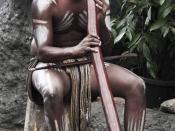Changing rights and freedoms of Indigenous Australians throughout the 20th Century
Analysing the information collected from the sites visited at Australia's capital, we create an evolving image illustrating the rights and freedoms of Aborigines throughout the 20th Century as laws and ideologies progressed. We are able to see the changing views of the Indigenous people from white Australia exemplified through the sites in Canberra.
Ever since British fleets first landed on our island, the Aborigines were faced with a problem. The new settlers did not recognise them as owners of the land as they did not develop it, but had instead roamed amongst it. The Aborigines had faced discrimination, oppression and violence. After federation, however, their rights and freedoms began to change dramatically throughout the 20th Century. Through that period of time, the Australian government has created and implemented policies concerning the Indigenous population, decisions which had all been made for "their own good".
These policies have included Protection, Assimilation, Integration, Self-determination and finally, Reconciliation.
At the beginning of a new century, when the 6 colonies settled in Australia became a federated nation, the Aborigines were seen as a "dying race" by white Australia. The constitution had only two references to the Indigenous Australians, one handed power over the Aborigines to the State Governments from the Federal Government; the other excluded them from the census. From the older sites of Canberra such as the Old Parliament House, we can see that there is no representation of any sort of Aboriginal culture or its peoples. This shows that back then Indigenous Australians were not recognised as part of our history or culture, or even our popularity. There were merely seen as part of the land's fauna or flora, as depicted in carvings seen at the National War Memorial. For this...



Great essay
tHIS IS A REALLY GOOD SOURCE OF INFORMATION. it is very accurate and extensive in its research. Thanks for submitting this
4 out of 4 people found this comment useful.